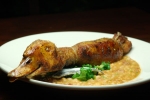Technique: Stuffed Duck Neck

 Will Blunt
Will BluntPhotos
Biographies
Recipe
Stuffed Duck Neck, Sauteed Kale, and White Beans
Chef Richard Knight and Jim Silk of Feast – Houston, TX
Photos
Chef-owner Richard KnightChef-owner James Silk, and Co-owner Meagan Silk of Feast – Houston, TX
There’s a reason the duck in “Stuffed Duck Neck Sausage” is grinning. Feast Co-chefs (and longtime Brit buds) Richard Knight and James Silk maintain a “happy animal program,” with an emphasis on the welfare of every animal that comes through their kitchen. “We always know where our animals come from,” says Knight, “what they’re fed, how they’re kept. It’s all done the right way.” The duck of the eponymous dish is raised locally, says Knight, by “a crazy Frenchman, of course,” (of course) who presumably treats his product exceedingly well. Even after it’s been fully disassembled for culinary use—feet for stock, breasts pan-fried, gizzards stuffed into pies, hearts and livers dripping in beef reduction on toast, wings into duck wing soup, and on and on—the duck’s still smiling.
In a way, the Stuffed Duck Neck does double duty, showcasing the indomitable post-mortem joy of a well-cared for duck and, more importantly, making use of duck neck skin, an otherwise disposable byproduct. While Knight and Silk and their endless font of nose-to-tail creativity found use for almost every part of the animal—“we played around with the heads a bit,” says Knight, “but never got much out of them”—the neck skin finally revealed its true calling as a natural sausage casing. The thickness (“we don’t prick them; it’s not necessary,” says Knight) and fattiness of the duck skins make them a perfect, flavorful insulation for whatever stuffing a chef’s heart desires. At Feast, where a few key pieces of kitschy pig-paraphernalia adorn the dining room, that tends to mean pork.
The chefs stuff the duck neck, skin un-pricked, head attached, with a mixture of ground pork butt, fresh herbs like sage (“good old sausage spice,” says Knight, “rough, nothing fancy”), parsley, orange zest, and a juniper-anise spice mixture that “gives [the stuffing] a bit of whazz.” Securing the top takes a little clever knife work, creating a notch in an inch or so of remaining neck bone so the string can dig deep for a secure tie; the bottom is secured with a few strong knots of butcher’s string. After quick, hot roast at 500°F, followed by a lower, slower roast, the duck neck emerges—smiling—in all its golden glory. Knight and Silk like to serve their “noble duck sausage” simply. “We grew up with a lot of crazy, offally bits, good old home-style comfort food from the old country,” Knight explains. In this case, comfort means some simple cassoulet-style beans and sautéed kale, all topped with a daffy smile—inter-species, beak-to-tail dining at its best.
 |
 |
 |
 |
Step 1: To separate the duck neck from the body, cut the skin around the neck, leaving the neck connected.
Step 2: Once the skin is cut, use a mallet and a cleaver to separate the neck from the body with a single strike.
Step 3: Pull the skin up to the duck’s head and cut off most of the neck, leaving about an inch of bone at the top of the neck.
Step 4: With a small sharp knife, cut a notch between the bone discs and make a groove all the way around the remaining neck bone at the top of the duck neck.
Step 5: Bring the top of the duck neck skin up to cover the notch in the neck bone and tie securely with butcher’s string.
Step 6: Prepare the filling by combining ground pork butt, fresh herbs, and spices, and stuff the neck generously. Tie off the end with butcher’s string, knotting several times.
Step 7: Put the duck neck on an oiled pan and baste with pork fat. Put in a 500°F oven for 10 minutes, turning every 2 to 3 minutes for even browning. Remove the duck to a 400°F oven to finish cooking.
Step 8: Serve the duck with white beans and sautéed kale, head still attached—“of course!”








